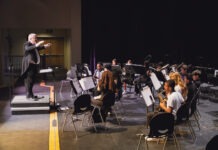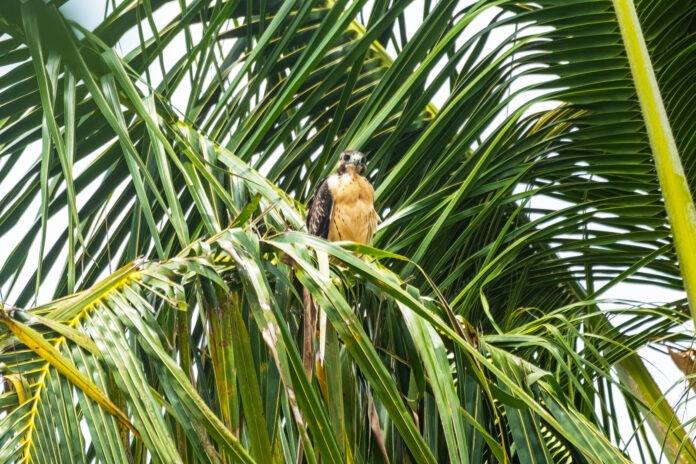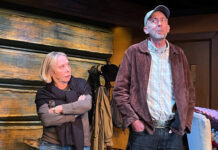I was walking my dog through the Meadows, thinking some very non-specific thoughts, when I heard the screaming. I had my suspicions about the source, but wanted to be sure. So we found a little spot in the shade and waited. The dog kept herself entertained by amiably sniffing at some weeds in the gravel.
There were a lot of competing noises – sirens, scooters, Harleys, Airbus A319s, a crew of roofers unloading a truck to work on a house down the street. But then there would be the occasional scream.
Given the nearby fences, cars and a few big, densely leafed trees that either bounced or absorbed sound, it was hard to tell where the screams were coming from.
They periodically would stop, so I would give up and start to walk again. Then they’d start all over – clear and angry sounding, an expansion followed by a contraction in a steep bell curve of sound.
After half a dozen cycles, I saw a light-phased short-tailed hawk fly down the street, coming toward the screams. It gave a half-hearted version of the call I’d been hearing, and looked about to land, but then was mobbed by a gray kingbird that didn’t want it in their airspace, so it flew off over the horizon.
I moved around the corner, and peered over a fence. Through a small hole in the foliage I finally saw it – a short-tailed hawk. It had a tawny shade in the breast, where an adult’s would be a clean white, and its face didn’t seem to have fully grown in with adult plumage, so I was pretty sure it was a young bird.
It was a relief knowing what I was hearing. I didn’t have binoculars or a camera, so I continued walking the dog. When I passed the spot again 20 minutes later, the young short-tail was still in the same spot, so I decided to run home for my camera. But I ran into Key West Poet Laureate Emily Shulten in the park and talked with her a bit, so when I finally made it back to the Meadows with my camera the bird had stopped screaming and moved on.
I have had suspicions about the short-tailed hawks nesting in the Keys for years. (I am not alone in this.)
Short-tailed hawks are one of the most interesting species in Florida. While common and populous in Central and South America, there is a separate, much smaller population – about 500 birds – in North America, all in Florida. The population is thought to be relatively steady, but at risk from loss of breeding habitat – primarily the mahogany swamps or other densely wooded areas.
They also come in two color phases – light and dark – which interbreed all the time but result only in either light-phase or dark-phase birds.
The birds are known to spend the breeding season in the upper two thirds of the state, and the winter in the lower two thirds of the state. But over the years I have had repeated sightings of them during every month on the calendar. It wasn’t proof they were breeding here, but it is hard to come up with a reason you would see them in June, July or August if they weren’t.
Two years ago I got a message that there was a breeding pair of hawks in a tree near the cemetery, and I suspected short-tails, but by the time I made it over to the nest it was empty. It was on a property being renovated by the former member of a famous boy band, and the tree was gone a few months later.
Last summer the folks at the Key West Wildlife Center had been keeping track of some young short-tails that were hanging around and making a ruckus on the other side of the cemetery. Unfortunately the young hawk that was seen was somehow electrocuted, and slowly grew more and more feeble, ultimately dying while the people at the center tried to rehabilitate it.
A few months ago Bernard Rasch told me he suspected there was a hawk nest in a tree in the Meadows, and said he and a friend were going to camp out in lawn chairs and watch to see if they could figure out where it was. I never really heard anything from him after that, but I drove and walked by the tree pretty regularly and didn’t see any hawks.
Parts of Bayview Park, and much of the sky above it, are visible from my back deck, and in the last few months I’ve seen a light-phase short-tail – presumably the same one – flying over the ball field several times. So I had my suspicions, which were confirmed, I felt, by the screaming young short-tail. Which wasn’t the same as finding a nest.
It was raining the next morning, but I texted Ellen Westbrook, who volunteers quite a bit at the Key West Wildlife Center, to see if she’d heard anything about the short-tails. She said no, but headed over after the rain stopped. A short time later she texted that she was hearing the screams from the young one.
I went over with my camera and saw the same young short-tail screaming in the same palm tree I’d seen it in the day before, and managed to get a few not great pictures. But we also found the adult light-phase short-tail sitting in a tree across the property, wings out, drying from the rain, looking, like many parents of screaming young offspring, a little stressed.
After a while it stepped out into the air, flapped a few times and landed in another tree across the block. Then she let out a call.
Ellen and I figured this was a parent trying to coax her reluctant young fledgling, who had just started flying very recently, to fly a little more. The fledgling stayed in the same spot, though, emitting regular screams.
Things started happening quickly after that. The light-phase adult took off and disappeared, but a few minutes later a dark-phase adult flew in and landed in a Norfolk pine way down the block. When we looked with binoculars, we could see two dark-phase short-tails up there – the perched adult, and a younger looking bird that was flapping and making short hops on the branches, but not leaving the tree. (We had the feeling the young dark-phase bird hadn’t actually flown yet.)
The original, light-phased young bird then left his palm tree and flew up into the Norfolk pine. Then the adult took off, and as soon as he left the pine, a mob of gray kingbirds went after him, chasing him out of the neighborhood.
I took a few more shots, especially of the two young birds up in the Norfolk pine.
In total, we’d seen four short-tails, two adults, and two young. Which is a good sign of breeding birds.
It wasn’t until I went home, offloaded my photos onto my laptop, and blew them up on the screen, that I saw the nest, high up in the Norfolk pine. So finally, proof of short-tails nesting in Key West. Game, set, match.

























